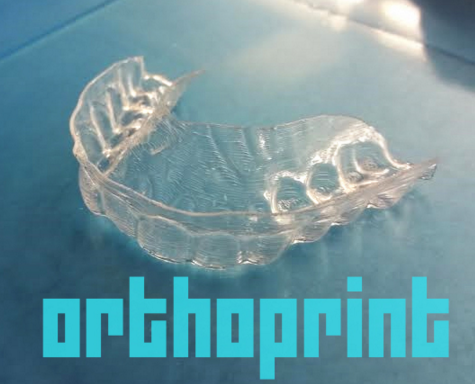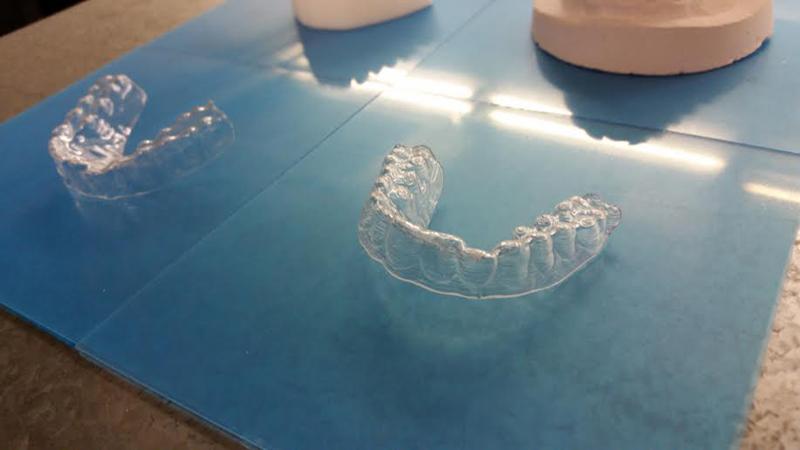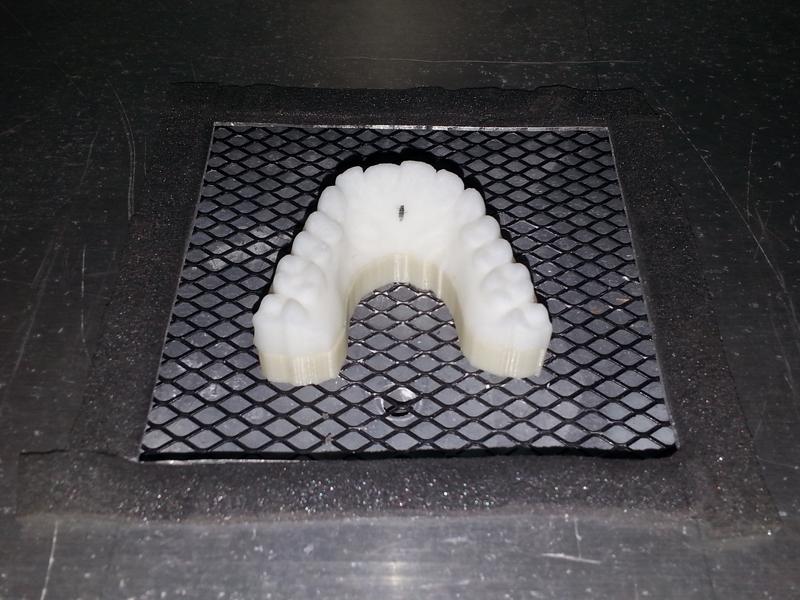 3D printing for the common folks just keeps getting better and better. While it’s been a boon to the thriving dental industry with 3D printers capable of helping professionals fabricate a wide range of products from dental models and appliances to dental restoration products for offices, what about everyone out there struggling with the costs of dental bills—and beyond that—orthodontics! If you have children, and especially teenagers, the word orthodontist strikes fear in your heart, and terror for the wallet, offering a feeling that can last for years. So how do we feel about the idea of Amos Dudley 3D printing his own Invisalign-esque braces? Although DIY dentistry is a term that makes me weak in the knees for sure, Dudley created a painless method for straightening his own teeth–and then some.
3D printing for the common folks just keeps getting better and better. While it’s been a boon to the thriving dental industry with 3D printers capable of helping professionals fabricate a wide range of products from dental models and appliances to dental restoration products for offices, what about everyone out there struggling with the costs of dental bills—and beyond that—orthodontics! If you have children, and especially teenagers, the word orthodontist strikes fear in your heart, and terror for the wallet, offering a feeling that can last for years. So how do we feel about the idea of Amos Dudley 3D printing his own Invisalign-esque braces? Although DIY dentistry is a term that makes me weak in the knees for sure, Dudley created a painless method for straightening his own teeth–and then some.
On a serious note, however, you may recall the lawsuit we followed last year as Align Technology Inc. sued Clear Correct Operating, LLC over intellectual property issues, mainly that of unfair trade practices and foreign infringement as they were sending files of client scans to Pakistan where they were converted to 3D models and then sent back to the US for 3D printing and sale. While lawsuit seems unlikely here, Dudley has certainly garnered a substantial amount of attention from those who do similar work in real offices, those who might like to try something similar—and those who just want to know if he is taking orders!
In a great blog, titled ‘Orthoprint, or How I Open-Sourced My Face,’ Dudley explains how he went to work on designing his own orthodontics after deciding his happiness was being unduly squelched by crooked teeth. Describing himself as a broke undergrad student lucky enough to have access to digital design and 3D printing tools, it occurred to him that with a bit of research and development of his own, he could correct his own teeth. And that, he did.
It turns out researching how to make teeth move around in your head is pretty interesting–and apparently, easy enough. Dudley, while concerned about a home-made dental disaster, did his background work. Once he had the basic concept of orthodontics down, he understood that he needed to 3D scan his teeth, make a model, and then figure out how to 3D print the appropriate materials—this being a thermoplastic aligner–in the appropriate shape. The next question was what tools he needed for self-orthodontics:
- 3D scanner
- Mold of the teeth
- CAD software
- High-resolution 3D printer
- Retainer material
- Vacuum forming machine
Dudley realized, unlike most of the general worldwide population (enter in, reason one why orthodontists make the big bucks), realized he could indeed figure out how to put his hands on all of these items. While his 3D printer was not capable of high enough resolution, he was able to use the Stratasys Dimension 1200es housed in a digital fabrication lab where he attends classes at the New Jersey Institute of Technology. There, he also happened to find a vacuum forming machine, and some NextEngine laser scanners.
For the retainer material, he purchased Keystone Pro-Form .030” plastic from eBay, realizing how crucial the proper material is due to issues with toxins, as well as durability. Considering he had tools accessible from a college lab, this process seems almost too easy—and looks like it might actually be sort of fun.
“I took a mold of my teeth with some cheap alginate powder, Permastone, and a 3D printed impression tray, to get a better picture of what was really going on,” said Dudley. “Notice LI-r (right lateral incisor) projected outward, and CI-r (right central incisor) depressed inward and overlapping.”
Once the mold was created, Dudley was on to the new challenge of casting.
“I put the mold upside down in a yogurt container, and then filled it with liquid Permastone. When it came out, I simply broke off the top to reveal the casting, and used a razor blade to smooth out the surrounding area. I added two small colored dots to the surface of the casting, which would serve as reference points for scaling the laser scan.”
 He sailed through laser scanning fairly effortlessly, baking each frame of animation into a new .stl model.
He sailed through laser scanning fairly effortlessly, baking each frame of animation into a new .stl model.
“Creating the animation was also fairly trivial–I separated the visible crowns of the teeth from the gumline, and then made a manifold model from each of the shells. I didn’t bother adjusting the geometry of the gums- they are soft. Then it was just a matter of animating them into their correct positions. I measured the total distance of travel, and divided it by the maximum recommended distance a tooth can travel per aligner,” said Dudley.
He then made all of his aligner steps, as well as a riser, meant to eliminate ‘draping artifacts’ as well as saving time. Because there were so many identical pieces, Dudley had to number them to tell them apart.
“The riser had the wonderful, unintended side effect of creating a perfect line, that I could trace with an x-acto to easily and consistently cut the 3D print from the unfinished vacuum formed aligner,” said Dudley, who then used his Dremel to sand off all rough edges.
The results are right here before you, and they are undeniably impressive. Dudley found his ‘DIY plastic aligners’ to be more comfortable than traditional braces, and his next plan is to make a number of retainers that he can wear at night, indefinitely. He also points out, as an added benefit, that these aligners work very well as both whitening trays that fit perfectly and night guards—for all those stressed out teeth-grinders out there.
While he might have been broke at the time of writing his blog and creating his braces, we have no doubt that this is a maker with a bright future—in fact, parents around the world right now are either trying to figure out how to do this and perhaps enroll at NJIT for access to all the right stuff, or better yet, busy delivering their kids straight to his front door for a consult! Here’s to Amos Dudley, who is indeed sticking it to the dental and orthodontics industry—with a bright, white new smile. Are you interested in trying to make something similar? Let’s talk about it in the 3D Printed Orthodontic Aligners forum over at 3DPB.com.

Subscribe to Our Email Newsletter
Stay up-to-date on all the latest news from the 3D printing industry and receive information and offers from third party vendors.
You May Also Like
Further Understanding of 3D Printing Design at ADDITIV Design World
ADDITIV is back once again! This time, the virtual platform for additive manufacturing will be holding the first-ever edition of ADDITIV Design World on May 23rd from 9:00 AM –...
3D Printer Maker EVO-tech Reborn as NEVO3D — Once More With Feeling
EVO-tech was a 3D printing service and original equipment manufacturer established in 2013 and based in Schörfling am Attersee, Austria. The company produced high-quality material extrusion systems featuring linear bearings,...
3D Systems Brings 3D Printed PEEK Cranial Implant to the U.S. with FDA Clearance
For more than 10 years, 3D Systems (NYSE:DDD) has worked hand-in-hand with surgeons to plan over 150,000 patient-specific cases, and develop more than two million instruments and implants from its...
CDFAM Returns to Berlin for Second Annual Symposium
The second CDFAM Computational Design Symposium is scheduled for May 7-8, 2024, in Berlin, and will convene leading experts in computational design across all scales. Building upon the first event...


































